This is the complete guide to boosting your case interview prep in 2023.
In this in-depth guide, you’ll learn:
- How to effectively prepare for case interviews
- How to turn your case interviews into job offers
- How to avoid the mistakes that lead to rejection
- And lots more
So, if you want to secure offers at McKinsey, BCG, or Bain & Company, this guide is for you.
Let’s dive right in.
Table of Contents
Case interview fundamentals
In this section, you’ll get a handle on the fundamentals.
Whether you are new to case interviews or want to ensure you are on the right track, you’ll love this section.
Then, in later sections, we’ll cover advanced tips, techniques, and strategies to ace your management consulting interviews.
But first, let’s cover the basics of case interview prep.
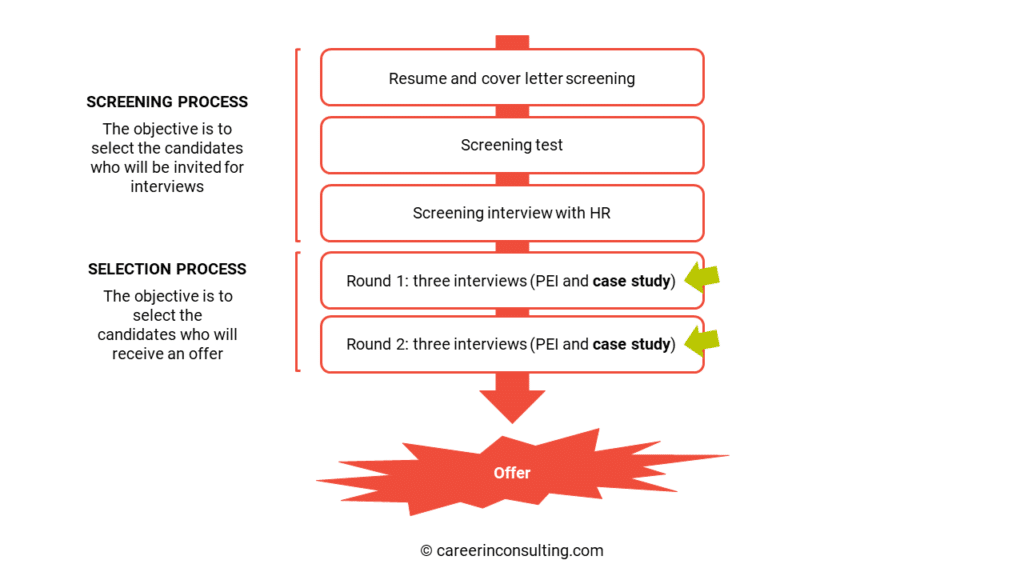
What is a case interview?
A case interview is a job interview technique
A case interview – or case study – is a job interview technique to assess a candidate’s potential to become a successful consultant.
To do so, management consulting firms ask candidates to solve real-life problems their clients face.
Hence, this perfectly simulates the job you must do as a Consultant.
For instance, here are two sample case questions from Bain & Company’s website.
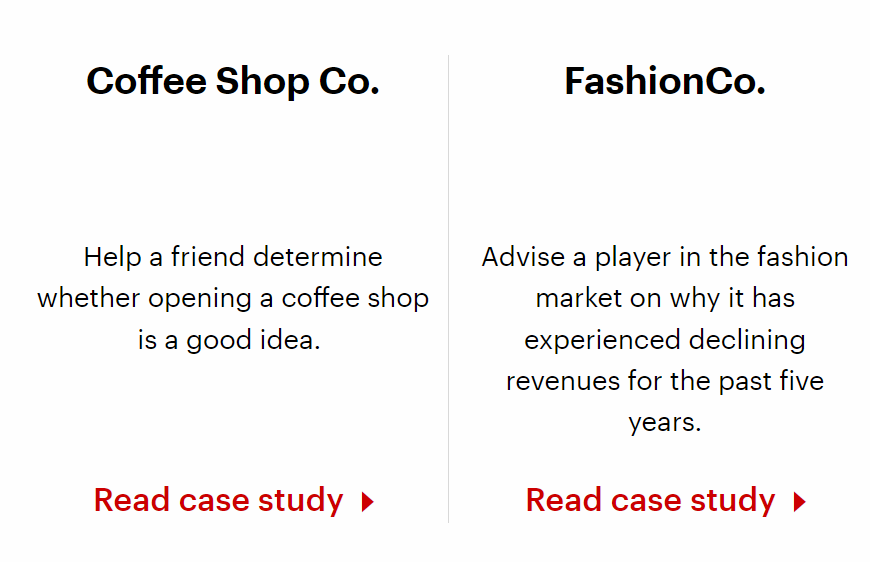
And here are more examples from the McKinsey & Company website.
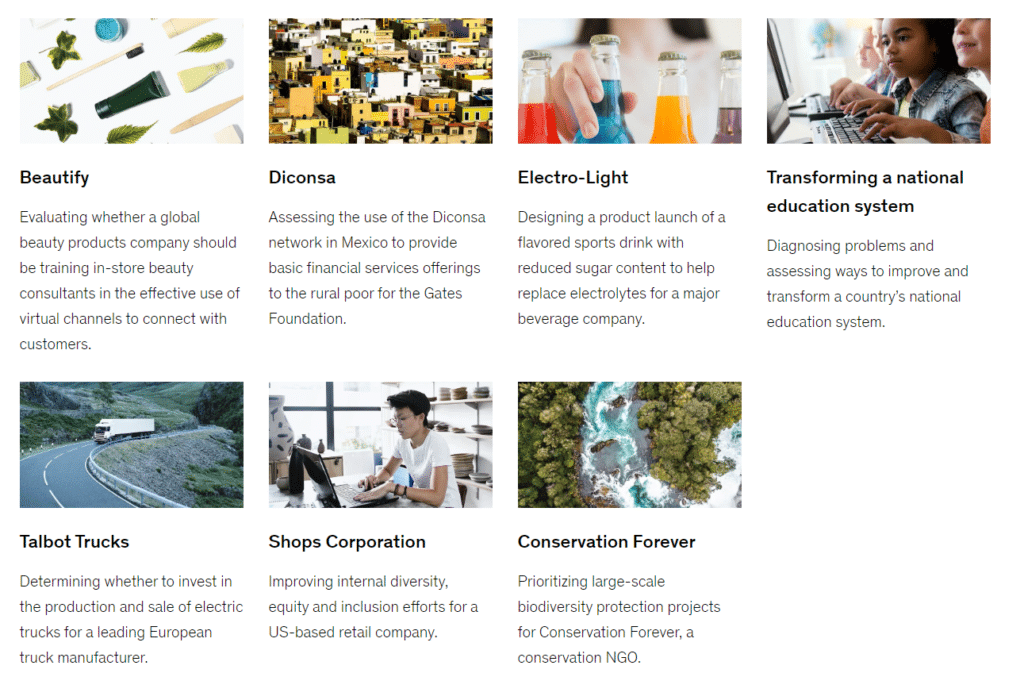
A case interview is a problem-solving test
To solve these real-life problems, you must go through a certain number of steps, such as identifying the key drivers of the problem, asking the right questions to walk your way through the case, analyzing data, and presenting a solution to the problem.
But don’t worry: I’ll detail these steps later in this guide.
The problems you have to solve in a case interview are diverse both in terms of industry (Hospitality, Transportation, Chemical, Banking, Oil & Gas, Private Equity, etc.) and business situation (improving sales or profits, decreasing costs, rethinking an organization, acquiring a company, etc.)
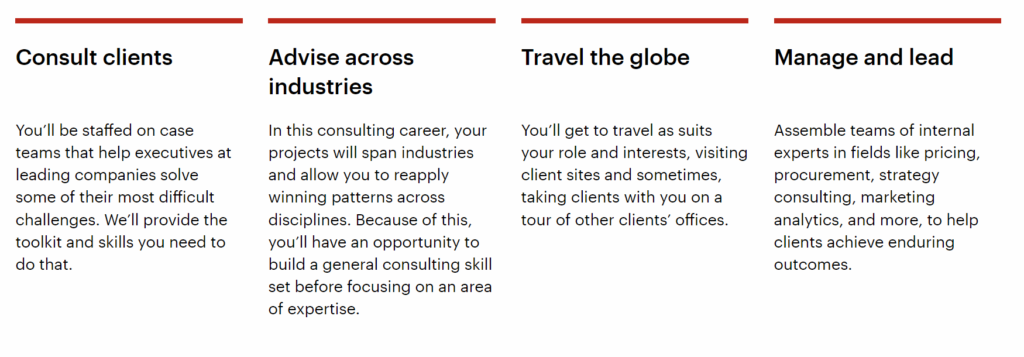
And they are usually taken from real-life projects done by the interviewers.
Another important rule in a case interview:
There is no right answer (but plenty of wrong answers).
Hence, what’s important for your interviews is your reasoning.
And this means they are more interested in your thinking process than a solution for the problem.
Here is an example from Bain’s website:
What is NOT a case interview?
I’ve been coaching candidates for over a decade.
And I’ve seen this misunderstanding too many times:
A case interview is NOT an exam.
Case interviewers are NOT testing your KNOWLEDGE or your memory.
Instead:
They are testing your COGNITIVE SKILLS.
Which means:
Your ability to effectively use and adapt your knowledge to solve complex problems.
That’s why memorizing frameworks or formulas is useless… and often counterproductive.
There is no shortcut to ace a case interview.
Instead, you must develop your problem-solving and communication skills.
Remember this:
A case interview should be a conversation between 2 consultants solving a business problem.
This is far from being a student answering exam questions on a piece of paper alone.
Who uses case interviews and why?
All top management consulting firms use case interviews to assess a candidate’s problem-solving skills.
So, why do consulting firms use case interviews in their interview process?
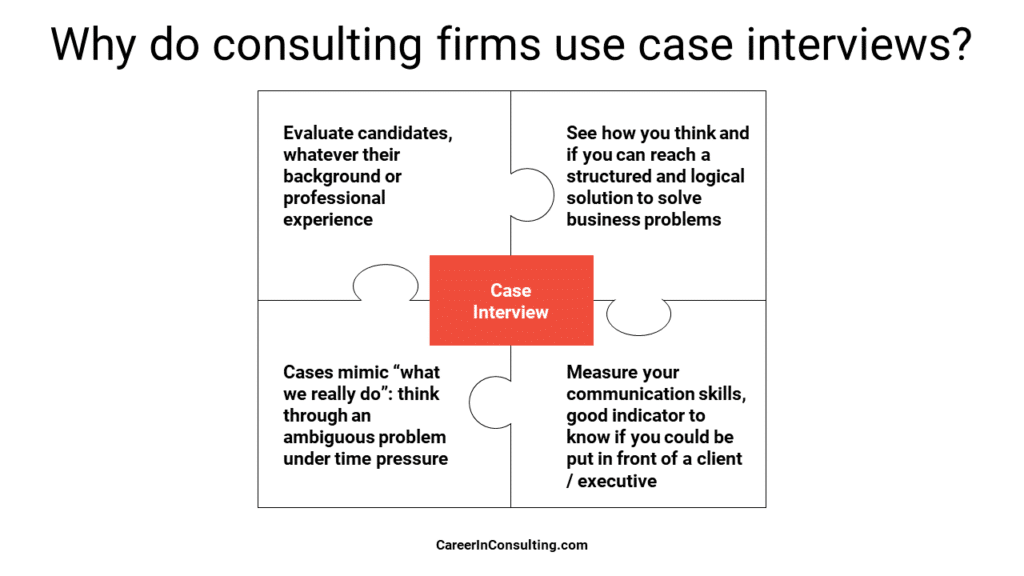
You must understand this:
Management Consultants consider themselves professional problem solvers.
And during the case interview process, they want to see if you are one of them.
They want to see if you think and speak like them.
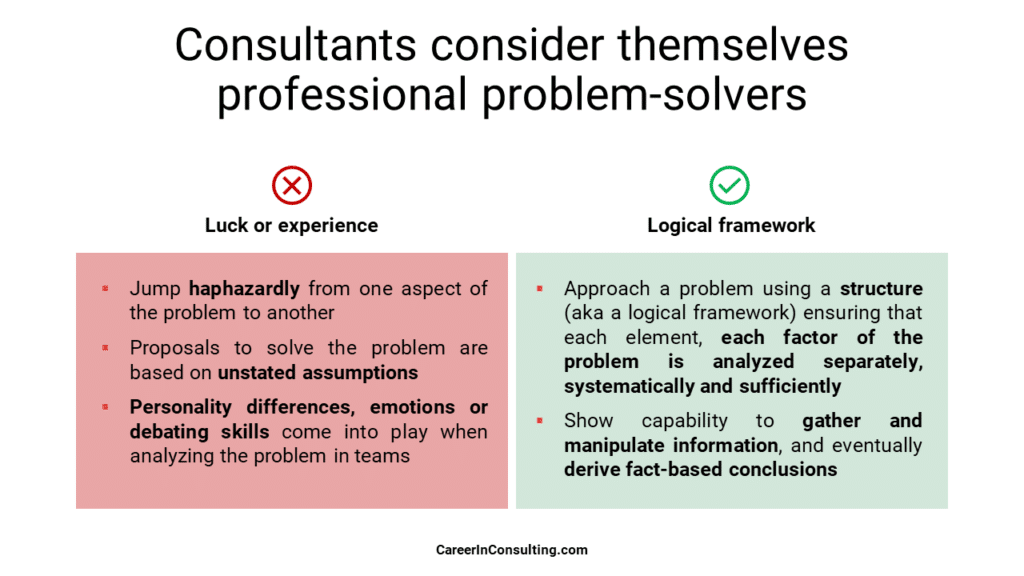
Here is a non-exhaustive list of consulting firms using case interviews in their interview process:
Oliver Wyman
Roland Berger
Strategy&
Kearney
OC&C
LEK
Monitor Deloitte
PWC
KPMG
E&Y
Note: This list is by no means exhaustive. Lots – if not all – boutique consulting firms use case interviews as well as part of their interview process.
The formats of case interviews differ from one firm to another.
And that’s what we are going to discuss in the next paragraph.
What are the different types of case interview formats?
Now, it’s time to discuss the two formats of case interviews:
Candidate-led case interviews
Interviewer-led case interviews
More specifically, you’ll learn what are the differences between a candidate-led and an interviewer-led case interview.
Also, you’ll learn what are the implications of these formats for your case interview preparation.
The first case interview format: Candidate-led case interviews
Most firms use a candidate-led format.
What does candidate-led mean?
In candidate-led interviews, the candidate is expected to drive the case from start to finish.
This means they are responsible for structuring the problem, asking the right questions, and leading the discussion towards a solution.
In other words, the candidate is in the driver’s seat.
They must proactively identify issues, prioritize them, and decide on the next steps.
Therefore, there’s often more room for creativity and exploration.
If the candidate decides to explore a particular area of the case in-depth, they have the freedom to do so.
The second case interview format: Interviewer-led case interviews
McKinsey uses interviewer-led interviews (so do – sometimes – Oliver Wyman and Strategy&).
In interviewer-led cases, the interviewers are more active in guiding the discussion.
After the candidates present the key topics to be analyzed to solve the business problem, the interviewers lead the direction on where to start diving into the analysis.
While the candidate must still showcase their problem-solving skills, the interviewer largely determines the case’s direction.
The interviewer might direct the candidate to specific areas they want to test, making the case feel more structured and segmented.
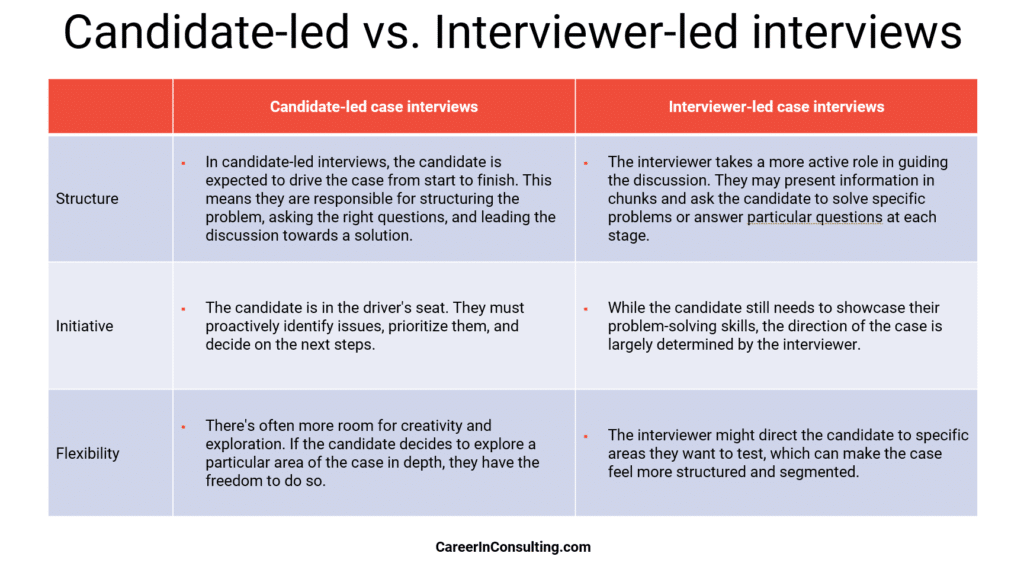
The implications of the case interview format for your case interview prep
For Candidate-led Interviews, you need to be comfortable with taking the lead.
This means you should practice deciding which areas to probe further and which to deprioritize.
And I’ve created a free consulting case interview preparation course to show you how to do it:
Get 4 Complete Case Interview Courses For Free

You need 4 skills to be successful in all case interviews: Case Structuring, Case Leadership, Case Analytics, and Communication. Join this free training and learn how to ace ANY case questions.
For Interviewer-led Interviews, you must be quick, adapt to new information, and change your approach as needed.
Therefore, active listening is crucial to ensure that you’re addressing the issues raised.
However, while there are distinct differences between candidate-led and interviewer-led case interviews, the core skills being tested are consistent across both formats.
What to expect in case interviews?
Most candidates hear “case interviews” for the first time when they decide to apply for consulting jobs.
And for most candidates, this is the biggest obstacle between them and their dream job.
So, in this section, we will go through the 5 steps of a case interview.
All interviewers from McKinsey, BCG, Bain, or other top consulting firms expect you to follow these 5 steps.
Note: The techniques and strategies to ace these steps will be discussed in the section “How to ace your case interviews.” later in this guide.
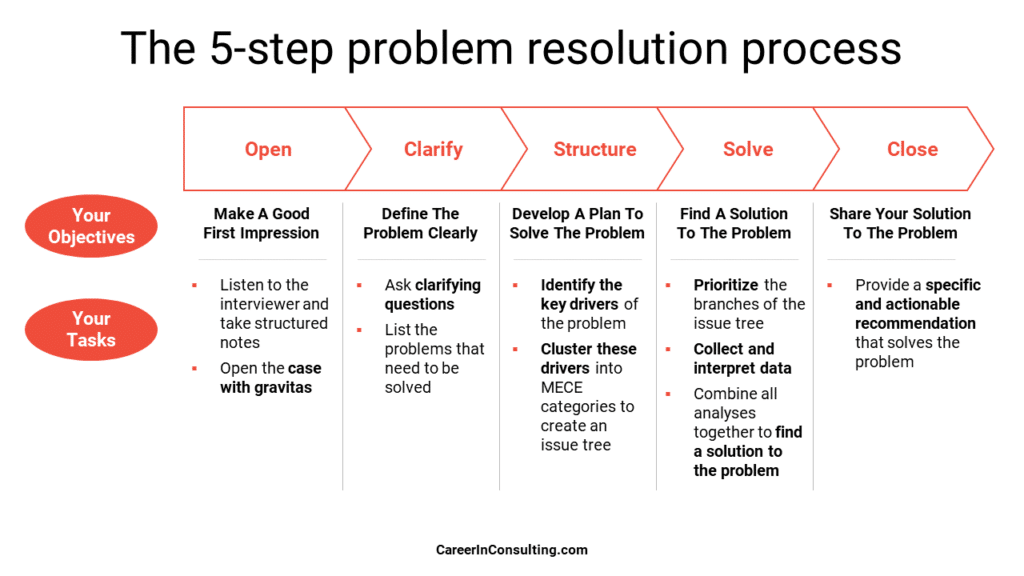
Open the case
A case interview starts with the interviewer sharing the case prompt with you.
In the case prompt?
The interviewer shares a client’s situation and the problem they are trying to solve.
While the interviewer speaks, you must take notes.
You must write down all the critical information and keywords of the case prompt on a piece of paper.
Don’t worry:
This guide will address how to recognize the “critical information and keywords” of a case prompt.
And after the interviewer finishes sharing the case question, it’s your turn to speak…
Clarify the problem
You can assume that all the case prompts will be ambiguous.
Some critical information will be missing.
Or some keywords will be ambiguous.
And it’s your first job to remove any ambiguity.
An example?
Imagine this case prompt:
Your client manufactures cars. They have been experiencing declining sales and are asking for your help.
In the above case prompt, you should clarify what types of cars they manufacture.
A mass-market model like a Toyota Corolla?
or a luxury model like a Ferrari Spider 488?
The case’s direction will be very different whether we discuss one model or another.
Consequently:
You must ask clarifying questions to understand precisely the situation and goal.
Also, if you don’t understand a word, ask your interviewer to define it.
Develop a tailored framework
For most candidates, this is the scariest part.
During this step?
You must develop a mutually exclusive and collectively exhaustive (known by its acronym: MECE) issue tree.
An issue tree can also be called a case interview framework (or case interview structure).
Now, let’s address the following questions:
What is a case interview framework?
Why is this important?
What are the characteristics of a good case interview framework?
First, let’s define what a case interview framework is.
A case interview framework is your plan to solve the problem.
In other words:
This is your roadmap to move from the problem to the solution.
And during the case, you’ll walk your interviewer through this roadmap.
This roadmap must include all the factors that influence the behavior of the problem.
For instance: volume and price influence the behavior of sales.
And these factors must be organized by following certain principles (the infamous MECE principle).
In other words:
All these factors must be organized in a mutually exclusive and collectively exhaustive way to ensure that there is no gap (no important factor is missing) and no overlap (no factor is counted twice).
Now, what makes a great case interview framework?
Watch this video detailing the three characteristics of a superior case interview framework:
MECE (mutually exclusive and collectively exhaustive)
Logic-driven
Tailored
Solve the problem
After you’ve presented your roadmap, you must ask relevant and insightful questions to the interviewer.
The goal?
Get data and information to solve the case.
Your interviewer can provide you with data in three forms:
Tables
Charts
Texts
Then your job is to interpret these data.
In other words:
You must turn these data into business insights.
Note: an insight is the meaning of the data in the context of the problem (more detail on that later).
This is called the “so-what” in top consulting firms.
At this stage, your interviewers mainly test your analytical skills and business judgment.
For instance, they ask themselves:
Can you connect the dots between different sets of data?
And can you derive conclusions from these sets of data?
Besides, interviewers also test your quantitative skills.
They might ask you to perform quick mental calculations (also known as case interview math).
And when you have formed many conclusions from the data analysis, you can derive a recommendation.
Now, it’s time to move to the next step.
Close the case with a solid recommendation
The final step consists of delivering your recommendation to your client.
This is when you tell your client what to do, why they should do it, and why it’s important.
This is when you shift from an “analysis mode” to a “presentation mode.”
In other words:
You are now talking to your client’s CEO.
To deliver your recommendation, you must follow the top-down communication principles popularized by Barbara Minto in her book “The Pyramid Principle” (a must-read if you want to have a successful business career).
Hence, you must:
Start with your recommendation (or your answer to the client’s question).
Provide supporting arguments, usually taken from the analyses you performed during the case.
Discuss the next steps your client must take.
At this stage, your interviewers mainly test your communication skills.
But they also test your business judgment.
For instance, by asking themselves if your recommendation is actionable or not.
And… that’s it!
You are now done with your case interview.
Or at least you have an overview of the different steps of a case interview.
Now, you can watch this video where I present the 5 steps in detail:
What do case interviewers look for?
In this section, you will understand how you’ll be evaluated.
There is no secret: You must understand the rules of the game to have a chance to win.
And most consultancies – if not all – use the same criteria to assess a candidate’s case interview performance.
But let’s be clear:
In a competitive sector like Consulting, you must be in the top 1% of candidates across all these criteria to land an offer.
So, if you’ve ever wondered what it takes to be in the top 1%, you’ll learn a lot from this section.
Hard skills: the 4Cs and business acumen
During the screening phase, HR professionals check your resume and cover letter to establish if you have the potential to be a good candidate.
And during the case interview process, Consultants test this potential to establish if you’ll become a best-in-class consultant.
In other words:
Consultants want to see if you have the skill set to become this best-in-class consultant.
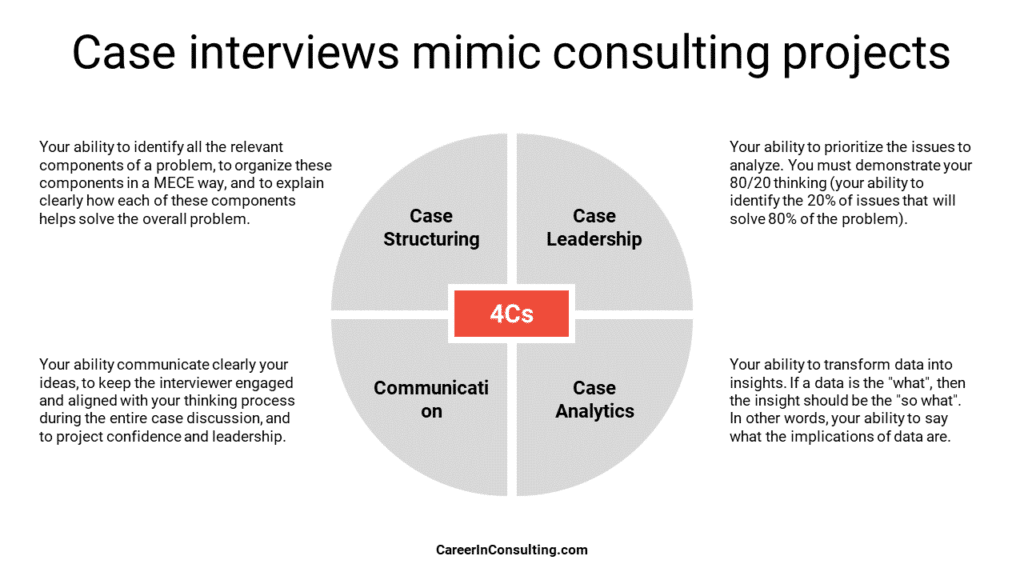
Case structuring
Interviewers assess your ability to identify all the relevant components of a problem, to organize these components in a MECE way, and to explain clearly how each of these components helps solve the overall problem.
Case leadership
Interviewers assess your ability to prioritize the issues to analyze. You must demonstrate your 80/20 thinking (your ability to identify the 20% of issues that will solve 80% of the problem).
Case analytics
Interviewers assess your ability to transform data into insights. If data is the “what,” then the insight should be the “so what.” In other words, your ability to say what the implications of data are.
Communication skills
Interviewers assess your ability to communicate your ideas clearly and keep the interviewer engaged and aligned with your thinking process during the entire case discussion.
Also, clear and concise communication shows your interviewers that you are client-ready.
Business acumen
Business acumen – or business sense skills- is the top 1% factor.
This is how:
An issue tree is more tailored to the problem to solve
Only the most impactful issues are addressed
The interpretations of data are more insightful
In short, this is your ability to understand what moves the needle in problem solving.
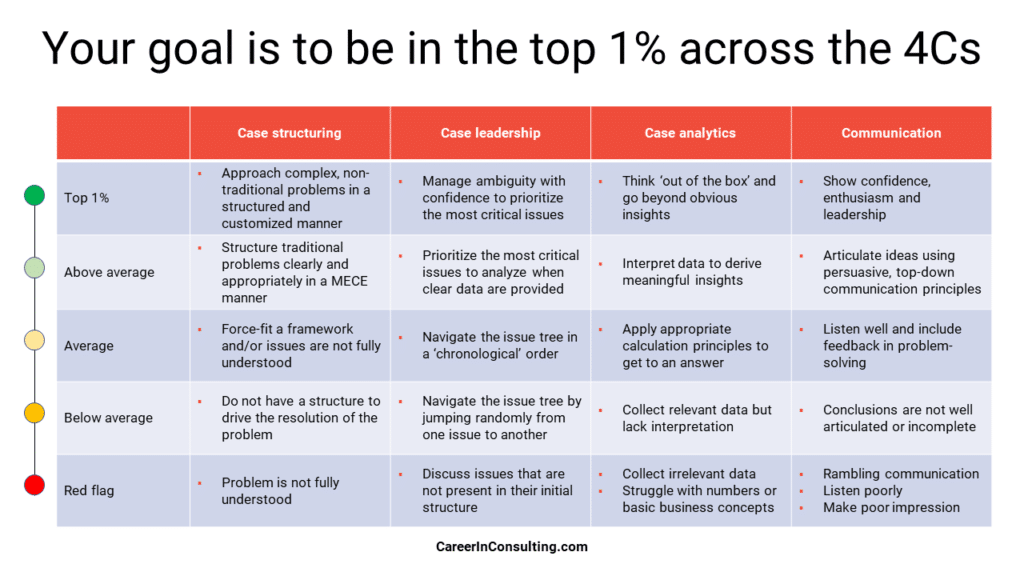
Soft skills: personal characteristics
Besides the above hard skills, consulting firms check if you have the personal characteristics demonstrated by the best-in-class consultants.
Coachability
Feedback is a significant part of the culture in consulting.
Consultants receive formal feedback every 3 months (after each project) and informal feedback throughout the project.
So, interviewers check how you react to feedback.
Do you listen well, understand, and implement feedback?
Or do you defend your opinion at all costs?
And be careful: lack of coachability is a red flag for many interviewers.
Curiosity
Are you excited about working on a new project (in a new industry) every 3 months?
If the answer is yes, consulting can be a good career option for you.
A curious mind (or “growth mindset”) is an important characteristic of being a successful consultant.
Therefore, your answers in fit interviews or your attitude during case interviews should showcase your burning desire to learn new things.
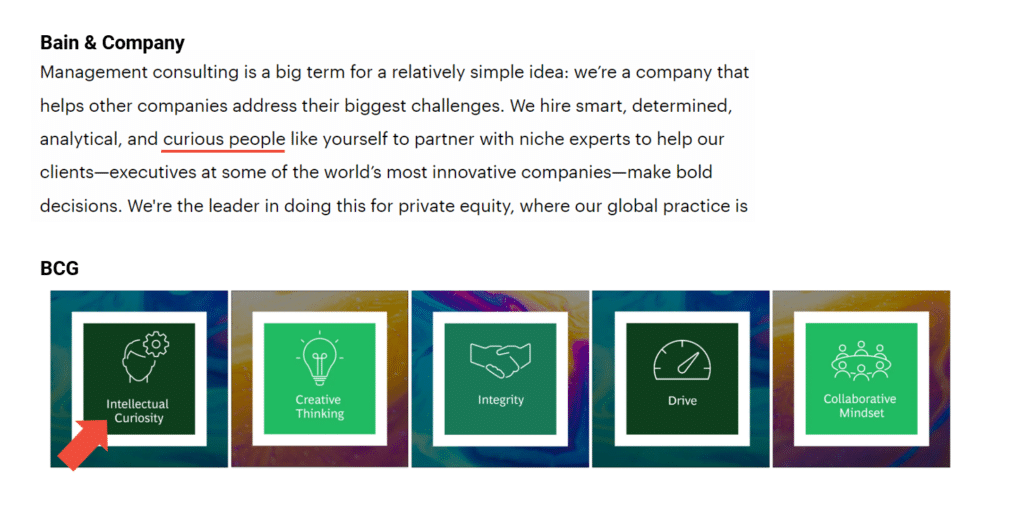
Comfort with ambiguity
In management consulting, you’ll have to solve tough business problems while having incomplete information.
So, your case interviewers test how you deal with ambiguity.
And a consulting case interview is full of ambiguities!
Check this article to learn how to clarify a case prompt.
Confidence & maturity
Consulting is a client-facing job.
And top consulting firm clients – corporations or public organizations – pay tons of money for their services.
So, interviewers ask themselves, “Do I feel comfortable putting this person in front of my client?”.
Important note: Since I sometimes get the question, you’ll have your chance regardless of your personality (introvert or extrovert).
Case interview examples from different consulting firms
I will share two in-depth case interview examples with you in this chapter.
That way, you can see the strategies and techniques from this guide in action.
Specifically, we will discuss the two types of case interviews used by top consulting firms:
Business cases
Market sizing questions
And for each type of case interview, I’ll share examples with you.
Note: per my experience, top consulting firms do not use brainteaser questions.
Therefore, this guide will not discuss this type of question.
However, I encourage you to check if your target company uses such questions (other consulting firms might still use brainteasers in their hiring process).
Business problem examples
Business cases are the most common questions you can have in a case interview.
You are asked to solve a business problem for a fictional client.
Similar to real consulting engagements, business cases are typically organized by industry and functional category.
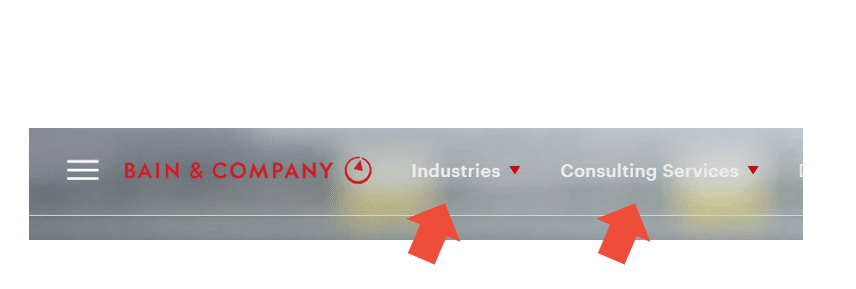
The industries you might encounter in a case interview are:
Aerospace,
Agriculture,
Automotive & Mobility,
Aviation
Chemicals,
Consumer Goods,
Defense,
Education,
Electronics,
Energy (Oil, Gas, Power),
Financial Services,
Healthcare & Life Science,
Industrial,
Infrastructure,
Logistics,
Materials,
Media,
Metals and Mining,
Paper and Packaging,
Pharmaceuticals,
Private Equity,
Public and Social Sector,
Real Estate,
Retail,
Semiconductors,
Technology & Telecommunication,
Transportation,
Travel and Tourism
Utilities & renewables.
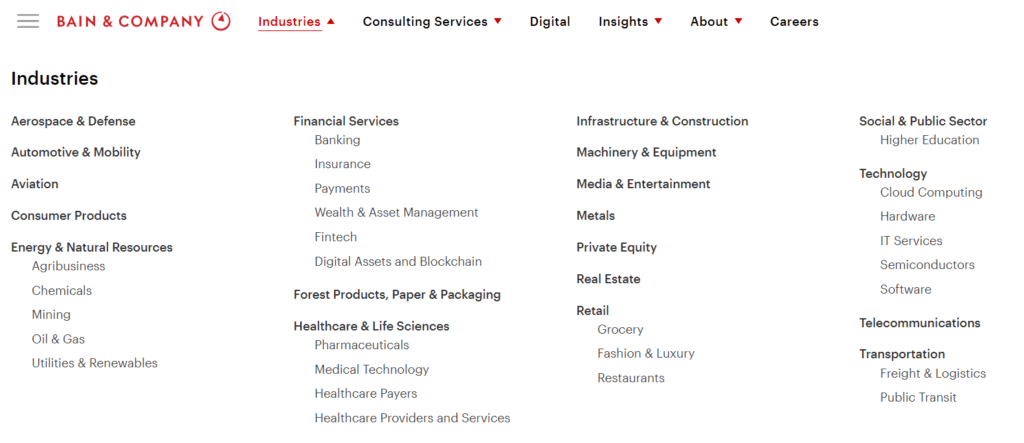
The functions you might encounter in a case interview are:
Corporate Finance,
Digital & Technology,
Manufacturing,
Mergers and Acquisitions,
Operations,
People and Organizational Performance,
Private Equity,
Recovery and Transformation,
Risk and Resilience,
Sales & Marketing,
Strategy,
ESG & Sustainability.

The following topics, which are not MECE, could be covered in case interviews depending on the function and the industry:
Growth strategies
Market entry
Pricing
Cost optimization
Organization optimization
Product launch
Profitability case interview
Etc.
Here is a first McKinsey case interview example:
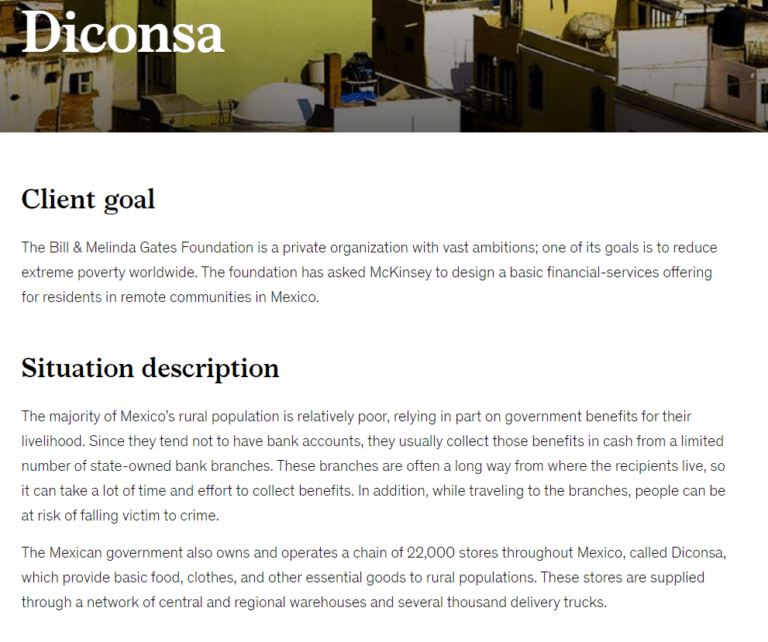
Source: https://www.mckinsey.com/careers/interviewing/diconsa
Another example?
Here is another McKinsey case interview example:
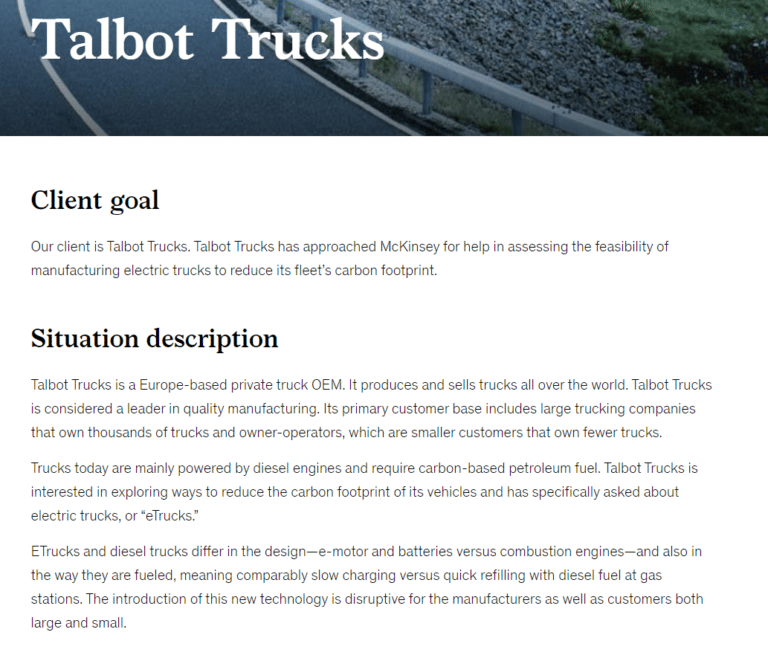
Source: https://www.mckinsey.com/careers/interviewing/talbot-trucks
And here is a BCG case interview example:
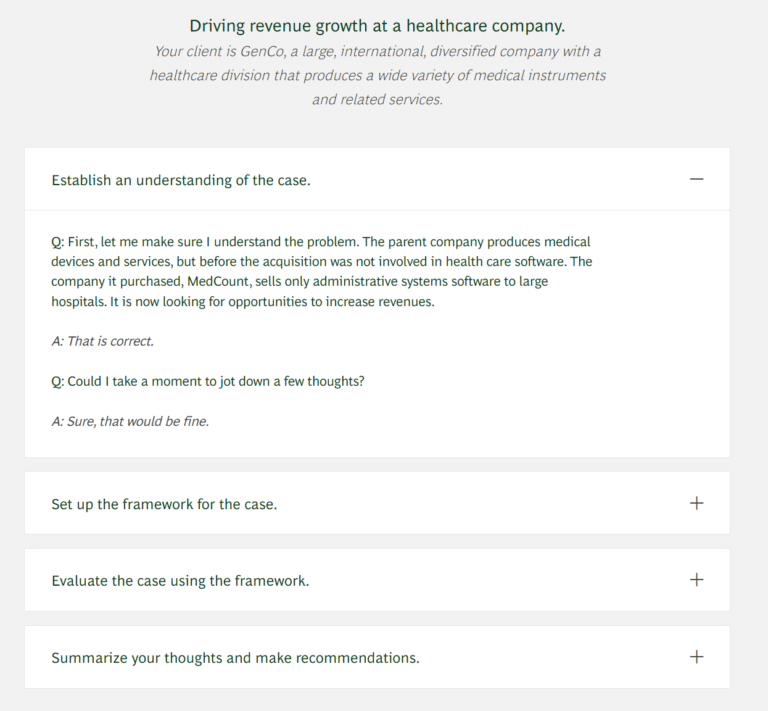
Source: https://careers.bcg.com/case-interview-preparation.
Finally, over 250 case interview examples (with answers) are found on this page.
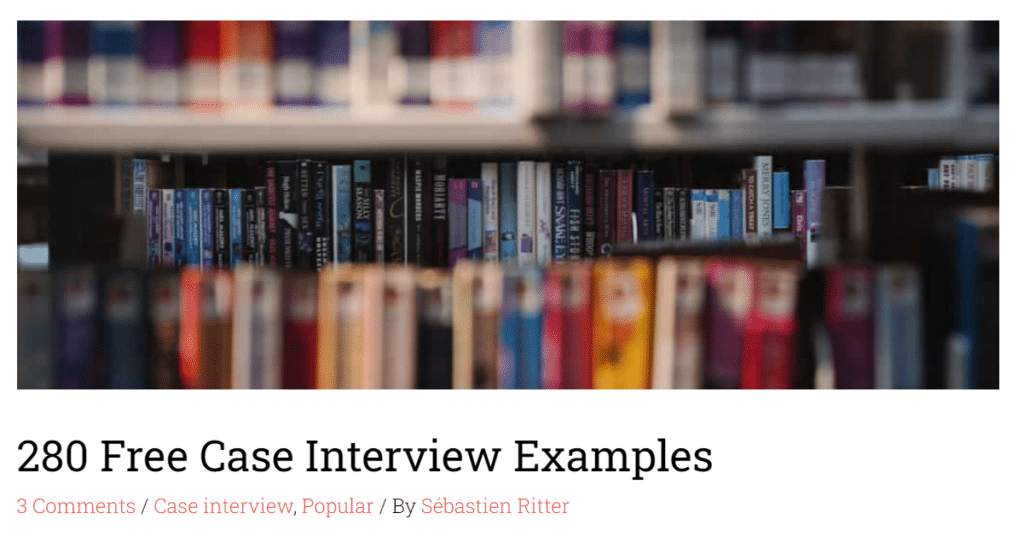
Sample market sizing questions
A market sizing question is a case interview where you have to estimate the size of something with no (or little) data available.
Market sizing questions can be embedded in business cases or can be asked as standalone questions.
For instance, here are some sample market sizing questions:
How many coffee cups does Starbucks sell in a year?
What volumes of beer are sold during an LA Lakers basketball game?
How many iPhones are currently being used in China?
What is the monthly profit of an average hair salon in the UK?
Market sizing questions are a very popular type of case interview at top consulting firms.
So let me be clear:
You can NOT land an offer at McKinsey, BCG, or Bain if you don’t know how to solve market sizing questions.
That’s why I’ve written a comprehensive step-by-step guide on market sizing questions here.
In this guide, you’ll learn my best strategies to solve the 3 types of market sizing questions.
Also, you’ll find plenty of examples to see how these strategies work.

Old vs. New cases (2021 - present)
For the past few years, case interviews have changed.
How?
Until a few years ago, case questions looked like this:
Declining sales
Market entry
Profitability case interview
Declining profits
M&A
Etc.
In short, the types of questions you can find in books like “case in point” or “case interview secrets.”
But today:
Less than 40% of case interviews are questions from the above list.
The other 60%?
Non-traditional case questions.
For instance, McKinsey recently asked this question:
Your client is a fictional country. They want to develop a plan to fight climate change. How would you help them with this question?

So, why have consulting firms decided to use this new type of question?
Because the goal of case interviews is to understand how you think.
And more precisely:
How you think outside your comfort zone.
Have you learned all the well-known business frameworks?
👉 They test your ability to solve business problems where these frameworks are irrelevant.
Do you have an Engineering degree?
👉 They will give you a case involving lots of business concepts.
Don’t have quantitative experience?
👉 They will give you a case with lots of math, charts, and numbers.
Etc.
And it makes a lot of sense.
Because it mimics the day-to-day job of a consultant:
Consultants are constantly outside their comfort zone.
And they are constantly exposed to new topics.
Now, the implications for you are very important.
You can’t only rely on well-known frameworks.
Instead: you must learn how to build your own tailored frameworks.
You must learn how to think with First Principles and top-down logic.
You must learn how to organize your ideas in a MECE way.
Even for non-traditional case questions.
And I’ve created 4 free consulting case courses to learn just that:
Get 4 Complete Case Interview Courses For Free

You need 4 skills to be successful in all case interviews: Case Structuring, Case Leadership, Case Analytics, and Communication. Join this free training and learn how to ace ANY case questions.
How to ace your case interviews
In this section, I’ll show you how to turn your case interviews into offers.
In fact, the strategies in this section have helped over 350 candidates land job offers at McKinsey, BCG, Bain, or any boutique consulting firms.
And the strategies I share here can be used in all types of cases: market entry, profitability case interview, M&A, etc.
Let’s start with how to open a case like a pro!
Acing the opening: remove ambiguities
There is a lot of misleading information online about how to open a case:
Paraphrase the case prompt (aka repeat information your interviewers already know).
Ask a maximum of 3 clarifying questions.
End by asking if there is any other objective you should know.
But there is a better way to open a case:
Add business colors.
Take the lead.
Ask clarifying questions (as much as necessary).
Do a smart recap.
Here’s the truth:
How you open a case sets the tone for the entire case.
Start poorly, and your interviewer won’t guide you much during the case.
On the other hand:
Give a strong first impression, and your interviewer will see you as one of them from the first seconds of the case.
And that can be a game changer in your performance and chances to land an offer.
Therefore, this must-read guide will show you how to start your case interview correctly.
Acing the case structuring: create the perfect issue trees
We discussed this before:
An issue tree is the strategic framework that guides your analyses and helps you answer the client’s question effectively.
Before we dive into the nitty-gritty, let’s revisit the three essential characteristics of a robust case structure:
1. MECE (Mutually Exclusive, Collectively Exhaustive): Your structure should cover all possible areas without any overlaps.
2. Logic-Driven: The structure should follow a logical flow, making the logical connection between the different areas and the problem clear.
3. Tailored: Your framework should be customized to the specific problem at hand, not a one-size-fits-all template.
It shows that you can think strategically, organize your thoughts, and approach problems methodically—all essential skills in consulting.
Take Your Case Structuring Skills to the Next Level
Ready to master the art of case structuring?
Sign up for our free 4-hour video case interview training course.
This comprehensive course will walk you through the intricacies of developing a winning case structure, complete with real-world examples and actionable tips.
Get 4 Complete Case Interview Courses For Free

You need 4 skills to be successful in all case interviews: Case Structuring, Case Leadership, Case Analytics, and Communication. Join this free training and learn how to ace ANY case questions.
Acing quantitative questions: conquering numbers!
The mere mention of case interview math questions can send shivers down the spines of candidates with weaker quantitative backgrounds.
But hold on!
These questions aren’t just about doing quick mental calculations.
In fact, interviewers are looking for three crucial elements:
Structured Approach: Can you systematically break down the problem?
Numerical Comfort: Are you at ease with numbers and capable of swift mental calculations?
Business Sense: Can you interpret the results in a way that makes business sense for the client?
In the realm of case interviews, math questions often serve to calculate data that fills in the gaps in a given problem.
For example, you might be tasked with:
Market Sizing: For instance, estimating the potential size of a market.
Financial Metrics: For instance, calculating performance indicators like Payback Period or ROI.
Solution Impact: For instance, assessing the potential cost savings or productivity gains from a particular initiative.
The Truth About Mental Math
The world of mental calculations in case interviews is fraught with myths.
Let’s debunk some:
Reality: Calculators are a no-go. You’re on your own.
Reality: A significant math mistake is often a one-way ticket to rejection.
Reality: While some may tell you it’s okay to round numbers, most interviewers would disagree.
The rules can vary depending on who’s sitting across the table from you, so always be prepared for the strictest guidelines.
Follow This 4-Step Approach to Ace Quantitative Questions
Step 1: Define an Arithmetic Equation
The first step is to translate the business problem into an arithmetic equation.
This is where your structured approach comes into play.
Step 2: Do the Math
The data needed to solve the equation are usually provided by the interviewer.
If not, don’t hesitate to ask.
Occasionally, you’ll need to make educated estimates.
When calculating, remember: accuracy trumps speed.
Step 2bis: Do a Sanity Check
Before you share your answer, do a quick sanity check.
Does the result make sense in the context of the problem?
If something feels off, revisit your calculations.
Step 3: Share Your Insights
This is where your business sense shines.
Interpret the numbers and discuss their implications for the client’s situation.
Step 4: Lead the Case
Based on your calculations and insights, guide the conversation toward actionable recommendations.
Here is an example:
Interviewer: “How many units does a car manufacturer need to sell to break even?”
Candidate: “To find the breakeven volume, we can use the equation: Fixed Costs / (Selling Price – Variable Costs). Given that the fixed costs are $10 million, the selling price per unit is $20,000, and the variable costs are $15,000, the breakeven volume would be 1,000 units.”
How to Practice Math Questions
To sharpen Your Skills:
Mock GMAT Tests: These tests are excellent for practicing a wide range of quantitative problems.
Case Interviews: Simulate the real experience by going through case interviews that include math questions.
But don’t limit yourself to traditional methods.
Various online platforms and apps are designed to help you practice mental calculations and case-specific math problems.
By mastering case interview math, you’re not just showcasing your ability to crunch numbers.
You’re proving that you can think critically, make data-driven decisions, and lead a case to its logical conclusion.
Acing chart interpretation questions
Knowing how to interpret charts should be part of your consulting toolbox.
And to crack the case, you’ll have to analyze data presented in the form of charts or data tables.
While it looks straightforward, the challenges are numerous:
The quantity of data presented can be huge, and your time to analyze these data is limited. And some firms – like BCG – like to present charts with lots of irrelevant data…
Charts can come in many forms: bar charts, line charts, pie charts, scatter plots, etc. You must know how to decode each type of chart.
The game you’re playing here is not to read the data correctly but to turn these data into insights (the “so-what”). Your business judgment will make the difference here.
You sometimes need to use data presented 5 minutes ago in another chart to complete the actual analysis.
Understand the different types of charts
A chart is an immensely powerful way of presenting numerical data. All the information is summarised in one go in a way that the eye can readily absorb.
Trends, proportions, and other relationships are revealed at a glance.
If you are unfamiliar with the different types of charts, I recommend reading the book: “Say It with Charts” by Gene Zelazny.
This book is a masterpiece when it comes to explaining why a type of chart is used to convey a certain type of message.
But if you don’t have time to read these books, remember just this:
Each chart has one (and one only) objective.
The main objective a chart can have is:
Identifying a trend (line charts or column charts)
Showing the relative contribution of different categories to a whole (pie charts)
Comparing different items against a metric (bar charts)
Identifying the correlation between 2 data sets (scatter plots)
So, the next time you see a chart, ask yourself:
What’s the chart type (pie chart, line chart, etc.)
What’s the objective of this chart (showing a trend, comparing items, etc.)
What do data say?
Next:
Let’s discuss how to master the exhibit reading.
Follow this 5-step approach to ace chart interpretation questions
Here is a 5-step approach to ensure you’ll never miss any insightful information from a chart:
Step 1: Understand the data represented.
Take the time to read the information about the chart (titles, labels, X-axis, Y-axis, units, footnotes, etc.)
And clarify any word or information that is not clear. Asking questions is part of the consultant’s job!
Per my experience, 80% of the chart interpretation mistakes come from misunderstanding the data represented.
Step 2: Ask for time to structure your thoughts.
It’s okay to ask for 30 seconds to 1 minute to structure your thoughts.
Don’t be afraid of the silence… your interviewer prefers to have a structured and insightful conversation rather than rambling.
Step 3: Define your goal (top-down vs. bottom-up approach)
This is the biggest mistake I see:
Candidates use a bottom-up approach instead of a top-down approach.
The difference?
With a bottom-up approach, candidates jump into the data and hope to find something insightful.
In other words, they start their analysis without a plan.
On the other hand:
Candidates with a top-down approach start with a plan before jumping into the data presented in the chart.
Their plan?
They start with the issue they were analyzing.
And list the data they need to solve this issue.
Finally, search for these data in the chart presented.
With this top-down approach, you will be able to sort the relevant data from the irrelevant information easily.
Step 4: Communicate your key insights and implications.
During this step, you tell your interviewer what the data means regarding the client’s problem.
Do NOT say obvious observations!
“This data is going down…”
“The value of <any metric> has been stable for the past 2 years…”
These are not insights… but obvious observations.
Instead:
Your job is to interpret the data.
Here are some questions to ask yourself:
What do these data mean for the client? 👉 Insights
What does the client should do? 👉 Implications
Step 5: Lead the case.
Regardless of the format of the case interview (interviewer-led or interviewee-led), I recommend proactively saying what the next steps are.
Discuss, based on your findings, what you want to discuss next.
How to practice chart interpretation questions?
First, you can practice with GMAT tests.
Here are some examples.
Besides, visit websites full of charts like The Economist, The Wall Street Journal, etc.
Find charts, draw conclusions from these charts, and read the article to check if your conclusions make sense.
Also, practice with the case examples you can find in these case books.
Acing market sizing questions
Do you struggle with market sizing questions?
This can include: How to start the case? Which clarifying questions to ask? How to organize my thoughts and build an issue tree? Which assumptions to make? Do I have to check if my estimate makes sense? If yes, how?
Answering a market sizing question can be very SIMPLE.
Actually, it is very simple: there is a PROVEN FORMULA for solving market sizing questions.
This PROVEN FORMULA is like a comprehensive guide: if you follow each step, you’ll QUICKLY answer ANY market sizing questions SUCCESSFULLY.
In this guide, I’ll reveal my PROVEN FORMULA to answer market sizing questions and show how to use it with two full examples (with answers).
You can find this comprehensive guide here.
Acing the closing: The Art of giving a Winning Recommendation to the CEO
You’ve analyzed the data, solved complex problems, and navigated through the case interview.
Now, it’s time to wrap it up with a compelling recommendation for the client’s CEO.
Your closing remarks can make or break your chances of landing that coveted consulting role.
Here’s how to avoid common mistakes and structure an impactful recommendation.
Mistake #1 When Closing the Case: Repeating the Analyses You've Done
You’re now speaking to the CEO, not a fellow analyst.
The CEO doesn’t care about the number of Excel models you’ve built or interviews you’ve conducted.
They want a clear, actionable solution to their problem.
So, skip the methodology and get straight to the point.
Mistake #2 When Closing the Case: Not Being Assertive
This is not the time for ambiguity or hedging.
CEOs seek decisive, confident recommendations.
If you’re not assertive in your closing, you risk losing the CEO’s trust and, consequently, the case.
Mistake #3 When Closing the Case: Not Having a Clear Recommendation
If the CEO is left wondering, “Okay, but what should I do?” after your presentation, that’s a red flag.
Your recommendation must be crystal clear, leaving no room for interpretation or doubt.
How to Close the Case: The Structure of an Amazing Recommendation
To craft a recommendation that hits the mark, follow this structure:
Step 1: Initial Question Asked
Begin with a one-sentence summary of the question you’re answering.
For example, “You asked us to determine whether you should launch this new shampoo?”
Step 2: Your Recommendation
Provide a straightforward answer to the initial question.
For instance, “You should launch this new shampoo.”
Step 3: The Supporting Arguments
List all the logical reasons that back your recommendation.
For example, “This new shampoo will add $10 million in profits and doesn’t require significant investment in R&D or new production equipment.”
Step 4 (Optional): The Next Steps
If applicable, outline the immediate actions the CEO should take to implement your recommendation.
The Role of Risk in Your Recommendation
While some coaches advise discussing risks separately, I believe risks should be integrated into your supporting arguments.
If you can’t mitigate the risks, your recommendation loses its value.
The Timeframe for Impact
Lastly, ensure your recommendation can deliver impact within the CEO’s tenure—typically less than five years.
A great recommendation is not just insightful but also timely.
Where to start: A comprehensive case interview preparation plan
Are you feeling overwhelmed by the thought of case interviews?
You’re not alone.
With all the resources available online, knowing what’s relevant and how to separate the wheat from the chaff is difficult.
But with the right preparation plan, you can make it!
This 3-step plan takes you from discovery to mastery, ensuring you’re well-prepared for your case interviews:
Step #1: Discovery
Step #2: Practice
Step #3: Mastery
Bonus step: Mastery+
Step 1: Discovery
The first step is all about understanding the landscape. You need to know what you’re up against before conquering it.
Key Activities
Research different types of case interviews and consulting firms.
Identify the skills commonly tested.
Conduct informational interviews with current consultants (this can also be an opportunity to validate whether consulting is a good fit for you).
Major Pitfalls to Avoid
Don’t assume all case interviews are the same.
Avoid neglecting the importance of networking early on.
Don’t underestimate the emotional job; build your confidence from the start.
Step 2: Practice
You’ve done your homework; now it’s time to get your hands dirty. Practicing case interviews is where you turn knowledge into skill.
Key Activities
Work on mock case interviews with peers or mentors.
Use case interview prep books and online resources to practice cases.
Track your performance to identify areas for improvement.
Major Pitfalls to Avoid
Don’t practice going through the motions; make each session count.
Avoid practicing only with friends who might not give honest feedback.
Don’t ignore your weaknesses; confront them head-on.
Step 3: Mastery
This is the final stretch. Mastery is where you develop and fine-tune your skills to become a top 1% candidate.
Key Activities
Think using first principles.
Seek feedback from industry professionals.
Develop your business acumen:: while you are not expected to have an in-depth knowledge of an industry, a high-level understanding will help to generate better ideas and insights.
Practice with a diverse set of cases (different situations and industries).
Practice with recent cases (read the section Old vs. New cases).
Conduct mock interviews under timed conditions.
Major Pitfalls to Avoid
Do you know the Dunning-Kruger effect?
If not, read this article because it can be what you need to land offers in consulting.- Don’t get complacent; always look for ways to improve.
Therefore, avoid the trap of overconfidence; humility can be your greatest asset.
Step 3bis: Mastery+
Think you’re ready?
Mastery+ is your chance to test your skills in a lower-stakes environment by practicing with Plan-B firms.
Yes, you read me well: practice case interviews with Plan-B firms.
Key Activities
Apply to consulting firms that are not your first choice.
Go through their interview process as if they were your top choice.
Use the experience to identify any remaining gaps in your preparation.
Major Pitfalls to Avoid
Don’t treat these interviews as mere practice; give them your all.
Avoid burning bridges; you never know when a Plan B could become a Plan A.
Don’t ignore feedback; even a rejection can be a valuable learning experience.
From Discovery to Mastery+, each step is a building block towards your ultimate goal: acing that case interview and landing your dream consulting job.
Many candidates without business or consulting experience did it, and so can you.
So, are you ready to embark on this transformative journey?
Start by learning how to solve case interviews and get tips to help you navigate this exciting path.
Get 4 Complete Case Interview Courses For Free

You need 4 skills to be successful in all case interviews: Case Structuring, Case Leadership, Case Analytics, and Communication. Join this free training and learn how to ace ANY case questions.
Finally, watch this video about how to prepare for case study interviews on the BCG website:
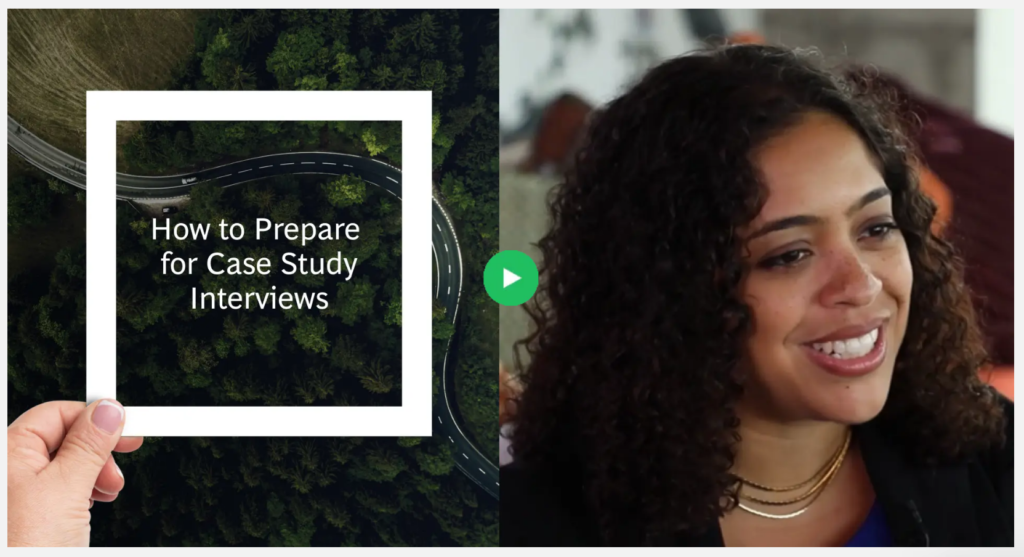
Frequently Asked Questions
How much time is needed to prepare for case interviews?
This is a tricky question.
Because it depends on factors such as:
Your strengths and weaknesses
The time you can dedicate to your preparation
Your learning pace
However, there is an important rule:
Start as soon as you can.
It takes time to be ready.
A case interview is NOT an exam: you can’t cram your consulting interview preparation in a week or two.
What are the most common case interview mistakes?
Check this article to find out what are the 16 case interview mistakes to avoid at all costs.
What are the differences between Round 1 (R1) and Round 2 (R2) cases?
Here are the main differences between first round interview and second round interview:
The seniority of your interviewers: R2 case interviewers are often Directors or Partners, while R1 case interviewers are Senior Consultants or Managers
Stress: Second-round interviews are usually more stressful. The reasons are numerous: the offer is getting closer and closer, interviewing with a Partner from a prestigious firm, etc.
Competitiveness: R2 candidates are competing with other R2 candidates. This tautology means that all the candidates who have made it so far are good, and the selection will be made on details.
The weight on assessment criteria: R2 assessment criteria are the same as R1 criteria (see the section “What do case interviewers look for?”). However, the importance of these criteria differs. Partners tend to value more criteria such as communication, confidence, leadership, and maturity.
Focus on your weaknesses: after an R1 case interview, the consulting firm lists your strengths and weaknesses. Therefore, an R2 case interview includes questions to validate (or invalidate) any doubt about your capacity to be a world-class consultant. For instance, if your quantitative performance was not positive, you can expect an R2 case interview with many quantitative questions.
However, I believe these differences should NOT influence your interview prep.
And, as discussed in this article, your goal is to be in the top 1% across the 4 main performance assessment criteria.
Finally, since we are talking about R2 interviews:
I can not stress enough the importance of fit interviews.
Your answers to questions such as “Why consulting?” or “Why McKinsey?” greatly influence the final decision.
Will my case interview be in person or via Zoom?
Check with your HR contact to validate this point.
Besides, you can read this McKinsey guide about virtual interviews.
Do you recommend practicing with a coach?
Being a coach myself, I’m obviously biased.
But I tried to give you a fair answer to help you decide what’s best for you.
First, let’s define what a good coach is.
A coach is someone with an extensive experience in consulting and in helping others land offers.
For instance, your friend who just got an offer at McKinsey is NOT a coach.
Remember:
Receiving an offer and explaining to others how to receive offers are two different things.
Therefore, the first criterion to decide if a coach can help you is to look at how much time they spend in:
Consulting,
Supporting candidates.
That being said, I recommend using coaching services if you can afford it.
Because this is the best way to get qualitative feedback.
You’ll know PRECISELY:
What is the distance between your performance and the performance of the top 1% of candidates.
How to quickly reduce this distance and become a top 1% candidate yourself.
At careerinconsulting.com, we have a unique coaching model:
We coach and support our clients until they receive an offer.
Interested?
If yes, check this page.
What are the basic business concepts to know?
I’ve written an article discussing some basic business concepts that might be helpful in acing your case interviews.
Any final tips?
Check these 16 case interview tips to move your skills to the next level.
For instance, you’ll learn the mistakes to avoid when developing an issue tree.
Also, check these case interview examples by clicking here.
How to get a case interview?
You get it:
Acing case interviews require a ton of hard work.
And you don’t want to put all this hard work into the trash by not being invited for interviews.
Unfortunately, the odds are against you: less than 30% of applicants are invited for interviews.
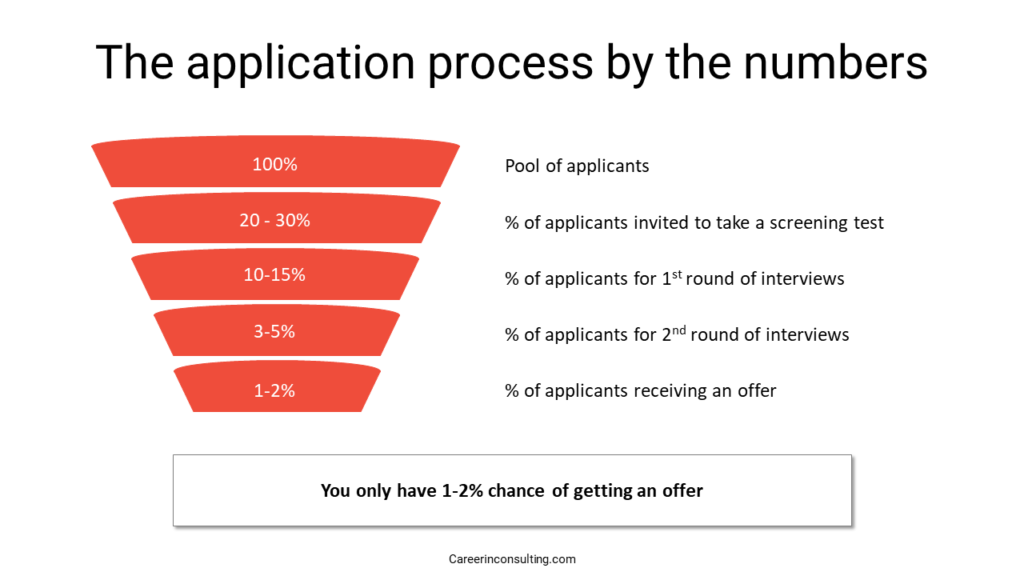
And don’t fool yourself:
Your prestigious college name and high GPA are insufficient.
Consulting firms look at a combination of factors to select the applicants invited for interviews.
So, how to pass the screening phase and be invited for interviews?
But don’t worry, I’ve written comprehensive guides that tell you how to do it.
Write a consulting resume
How to make your resume stand out?
By writing EPIC bullet points!
So, check this step-by-step guide to turn your resume into an outstanding resume.
In this comprehensive guide, you’ll learn:
What matters the most to recruiters in consulting
How to stand out from the hordes of other applicants
What are the most common mistakes that lead to rejection (and how to avoid them)
Also, you can download templates for McKinsey, BCG, and Bain & Company.
And here is the best part:
You’ll get an exhaustive checklist to assess the readiness of your CV.
Write a consulting cover letter
At the beginning of the interview process, recruiters from top consulting firms want to know you better.
They want to know who the person is beyond the amazing achievements on your CV.
So, if you wonder how to express your motivation to join a firm, this step-by-step guide is for you.
Also, you can download winning cover letter examples that passed the screening phase at top consulting firms.
See you there!
Beyond case interview prep: Fit interview questions
Your case interview performance counts for 50% of the interviewer’s decision.
The other 50%?
Your fit interview (aka personal experience interview) performance.
So, you can’t overlook your personal experience interview preparation.
Are you in one of the following situations?
I’ve just been accepted at [fancy MBA program]. So, I know how to present myself.
I’ve just been accepted at [fancy non-consulting company]. So, I know how to present myself.
I’ve had lots of job interviews in the past. This is not new to me. Instead, I prefer to spend my time on case interview preparation because case interview is new to me.
Wrong!
Wrong!
Wrong!
Your preparation must be aligned with the specific requirements of consulting firms.
In other words, even if some questions are typical job interview questions (e.g., “Tell me about yourself”), their expectations are different.
For instance, consulting firms assess your strategic thinking skills even in fit interviews.
Besides, they want to understand why you are genuinely interested in pursuing a career in consulting.
Thus, here is a series of articles to help stand out during your fit interviews:
How to answer the “Tell me about yourself” question
How to answer the “Why consulting” question
How to answer the “Why Mckinsey or BCG or Bain” question
How to answer behavioral interview questions using the STAR framework
Read these articles, and you’ll be covered for the main personal experience interview questions.
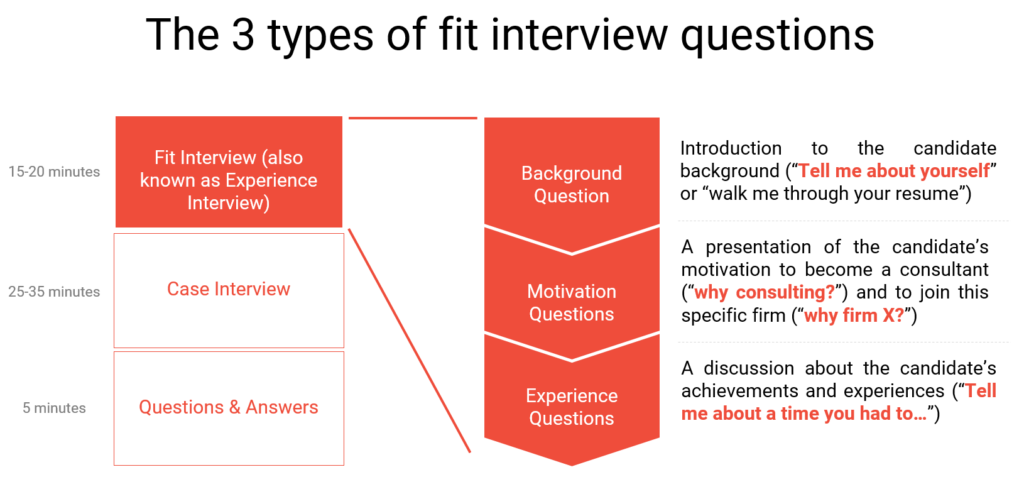
Conclusion
Case interviews mimic what consultants do: solving business problems.
And often, there is no right answer.
Instead:
What’s important is to show how you think.
So, I hope this guide will help ace your consulting interviews and start your career in management consulting at Boston Consulting Group or any top consulting firm.
I’d love to hear from you: What’s your biggest challenge in case interview prep?
Let me know by leaving a quick comment below right now.
Next:
-Want to know all the secrets of the consulting interview process?
👉 Check this article about the McKinsey recruitment process.
👉 Also, check this article about the Boston Consulting Group recruitment process.
Want more case interview examples? Or start to practice cases?
👉 Check this page: https://careerinconsulting.com/case-interview-examples/
You’ll find plenty of Bain case interview examples, for instance.
Finally, want to ace personal experience interview questions?
👉 Check this page: https://careerinconsulting.com/mckinsey-pei/
Get 4 Complete Case Interview Courses For Free

You need 4 skills to be successful in all case interviews: Case Structuring, Case Leadership, Case Analytics, and Communication. Join this free training and learn how to ace ANY case questions.
SHARE THIS POST

Pingback: Tell me about yourself: how to answer this question (with examples) - Career in Consulting
Pingback: 280 Free Case Interview Examples - Career in Consulting
Hi Sebastien, thank you for your informative article.
I do struggle to assign 7 McKinsey cases into the above-provided groups, they seem to get a bit more creative every year! Do you mind commenting or advising on those?
Case/Type:
1) Case: Beautify, Potential Type: Take a strategic decision
2) Case: Diconsa, Potential Type: Take a strategic decision
3) Case: Eletro-Light, Potential Type: Take a strategic decision)
4) Case: National Education System, Potential Type: ?
5) Case: Talbot Trucks, Potential Type: Take a strategic decision
6) Case: Shops Corporation, Potential Type: ?
7) Case: Conservation Forever, Potential Type: ?
Hi. thank you for your message. Where can I find the above cases?